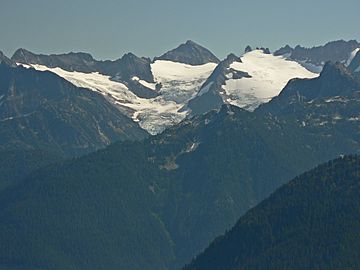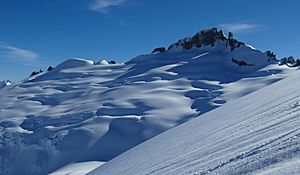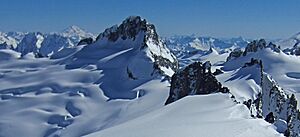Klawatti Peak facts for kids
Quick facts for kids Klawatti Peak |
|
|---|---|

Klawatti Peak (center) lies between Austera Peak (left) and Tepeh Towers (right). Three-lobed McAllister Glacier covers its northwest face.
|
|
| Highest point | |
| Elevation | 8,485 ft (2,586 m) |
| Prominence | 685 ft (209 m) |
| Geography | |
| Location | North Cascades National Park, Washington, U.S. |
| Parent range | Cascade Range |
| Topo map | USGS Forbidden Peak |
| Type of rock | Eldorado Orthogneiss |
| Climbing | |
| First ascent | 1940 by Lloyd Anderson, Karl Boyer, Tom Gorton |
Klawatti Peak is a tall mountain in North Cascades National Park in Washington, USA. It stands about 8,485 feet (2,586 m) high. What makes Klawatti Peak special is that it's a nunatak. This means it's a mountain peak that sticks out from a surrounding area of ice and glaciers.
Three large glaciers surround Klawatti Peak: the Klawatti Glacier to its east, the McAllister Glacier to its northwest, and the Inspiration Glacier to its south.
Weather Around Klawatti Peak
Klawatti Peak is located in a special climate zone called the marine west coast climate. This means it gets a lot of rain and snow. Most of the weather systems start over the Pacific Ocean. They then travel northeast towards the Cascade Range.
As these weather systems reach the tall peaks of the Cascade Mountains, the air is forced to rise. When the air rises, it cools down and drops its moisture as rain or snow. This process is called Orographic lift. Because of this, the western side of the North Cascades gets a lot of precipitation, especially heavy snowfall in winter.
During the winter, the weather is usually cloudy. But in the summer, high-pressure systems over the Pacific Ocean often bring clear skies. The best time for climbing Klawatti Peak is usually from July through September, when the weather is most favorable.
How Klawatti Peak Was Formed
The North Cascades area has some of the most rugged and dramatic landscapes in the Cascade Range. You can see sharp peaks, rocky ridges, deep valleys carved by glaciers, and tall, pointed granite rocks. These amazing features were created by geological events that happened millions of years ago. These events caused huge changes in the land's shape and height, which also led to different climates.
The Cascade Mountains began forming millions of years ago, during a time called the late Eocene Epoch. This happened because the North American Plate (a huge section of the Earth's crust) was slowly moving over the Pacific Plate. This movement caused a lot of volcanic activity. Also, smaller pieces of the Earth's crust, called terranes, joined together to form the North Cascades about 50 million years ago.
During the Pleistocene period, which started over two million years ago, huge sheets of ice called glaciers repeatedly moved across the land. As they advanced and then melted back, they scraped and shaped the landscape. They left behind piles of rock and debris. The "U"-shaped valleys you see in the area today were carved out by these glaciers. The combination of land being pushed up (called uplift) and cracks forming in the Earth's crust (called faulting), along with the action of glaciers, created the tall peaks and deep valleys of the North Cascades.






